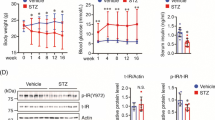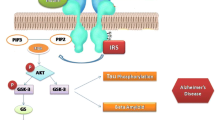Abstract
Neuronal insulin signaling abnormalities have been associated with Alzheimer’s disease (AD). However, the specificity of this association and its underlying mechanisms have been unclear. This study investigated the expression of abnormal serine phosphorylation of insulin receptor substrate 1 (IRS1) in 157 human brain autopsy cases that included AD, tauopathies, α-synucleinopathies, TDP-43 proteinopathies, and normal aging. IRS1-pS616, IRS1-pS312 and downstream target Akt-pS473 measures were most elevated in AD but were also significantly increased in the tauopathies: Pick’s disease, corticobasal degeneration and progressive supranuclear palsy. Double immunofluorescence labeling showed frequent co-expression of IRS1-pS616 with pathologic tau in neurons and dystrophic neurites. To further investigate an association between tau and abnormal serine phosphorylation of IRS1, we examined the presence of abnormal IRS1-pS616 expression in pathological tau-expressing transgenic mice and demonstrated that abnormal IRS1-pS616 frequently co-localizes in tangle-bearing neurons. Conversely, we observed increased levels of hyperphosphorylated tau in the high-fat diet-fed mouse, a model of insulin resistance. These results provide confirmation and specificity that abnormal phosphorylation of IRS1 is a pathological feature of AD and other tauopathies, and provide support for an association between insulin resistance and abnormal tau as well as amyloid-β.





Similar content being viewed by others
References
Armstrong RA, Cairns NJ, Lantos PL (1999) Quantification of pathological lesions in the frontal and temporal lobe of ten patients diagnosed with Pick’s disease. Acta Neuropathol 97:456–462
Aviles-Olmos I, Limousin P, Lees A, Foltynie T (2012) Parkinson’s disease, insulin resistance and novel agents of neuroprotection. Brain. doi:10.1093/brain/aws009
Bang S, Kim S, Dailey MJ et al (2012) AMP-activated protein kinase is physiologically regulated by inositol polyphosphate multikinase. Proc Natl Acad Sci 109:616–620. doi:10.1073/pnas.1119751109
Bennett DA, Schneider JA, Wilson RS et al (2005) Amyloid mediates the association of apolipoprotein E e4 allele to cognitive function in older people. J Neurol Neurosurg Psychiatry 76:1194–1199. doi:10.1136/jnnp.2004.054445
Bennett DA, Schneider JA, Wilson RS et al (2004) Neurofibrillary tangles mediate the association of amyloid load with clinical Alzheimer disease and level of cognitive function. Arch Neurol 61:378–384. doi:10.1001/archneur.61.3.378
Bomfim TR, Forny-Germano L, Sathler LB et al (2012) An anti-diabetes agent protects the mouse brain from defective insulin signaling caused by Alzheimer’s disease- associated Aβ oligomers. J Clin Invest 122:1339–1353. doi:10.1172/JCI57256
Cairns NJ, Bigio EH, Mackenzie IRA et al (2007) Neuropathologic diagnostic and nosologic criteria for frontotemporal lobar degeneration: consensus of the Consortium for Frontotemporal Lobar Degeneration. Acta Neuropathol 114:5–22. doi:10.1007/s00401-007-0237-2
Craft S, Baker LD, Montine TJ et al (2011) Intranasal insulin therapy for alzheimer disease and amnestic mild cognitive impairment: a pilot clinical trial. Arch Neurol. doi:10.1001/archneurol.2011.233
Craft S, Watson GS (2004) Insulin and neurodegenerative disease: shared and specific mechanisms. Lancet Neurol 3:169–178. doi:10.1016/S1474-4422(04)00681-7
Dickson DW, Bergeron C, Chin SS et al (2002) Office of rare diseases neuropathologic criteria for corticobasal degeneration. J Neuropathol Exp Neurol 61:935–946
Dickson DW, Braak H, Duda JE et al (2009) Neuropathological assessment of Parkinson’s disease: refining the diagnostic criteria. Lancet Neurol 8:1150–1157. doi:10.1016/S1474-4422(09)70238-8
Eldar-Finkelman H, Krebs EG (1997) Phosphorylation of insulin receptor substrate 1 by glycogen synthase kinase 3 impairs insulin action. Proc Natl Acad Sci 94:9660–9664
Eldar-Finkelman H, Krebs EG (1997) Phosphorylation of insulin receptor substrate 1 by glycogen synthase kinase 3 impairs insulin action. PNAS 94:9660–9664. doi:10.1073/pnas.94.18.9660
Geser F, Brandmeir NJ, Kwong LK et al (2008) Evidence of multisystem disorder in whole-brain map of pathological TDP-43 in amyotrophic lateral sclerosis. Arch Neurol 65:636–641. doi:10.1001/archneur.65.5.636
Giasson BI, Duda JE, Quinn SM et al (2002) Neuronal alpha-synucleinopathy with severe movement disorder in mice expressing A53T human alpha-synuclein. Neuron 34:521–533
Grimes CA, Jope RS (2001) The multifaceted roles of glycogen synthase kinase 3beta in cellular signaling. Prog Neurobiol 65:391–426
Hanger DP, Hughes K, Woodgett JR et al (1992) Glycogen synthase kinase-3 induces Alzheimer’s disease-like phosphorylation of tau: generation of paired helical filament epitopes and neuronal localisation of the kinase. Neurosci Lett 147:58–62. doi:10.1016/0304-3940(92)90774-2
Hauw JJ, Daniel SE, Dickson D et al (1994) Preliminary NINDS neuropathologic criteria for Steele-Richardson-Olszewski syndrome (progressive supranuclear palsy). Neurology 44:2015–2019
Henriksen EJ, Kinnick TR, Teachey MK et al (2003) Modulation of muscle insulin resistance by selective inhibition of GSK-3 in Zucker diabetic fatty rats. Am J Physiol Endocrinol Metab 284:E892–E900. doi:10.1152/ajpendo.00346.2002
Hirosumi J, Tuncman G, Chang L et al (2002) A central role for JNK in obesity and insulin resistance. Nature 420:333–336. doi:10.1038/nature01137
Hong M, Lee VM-Y (1997) Insulin and insulin-like growth factor-1 regulate tau phosphorylation in cultured human neurons. J Biol Chem 272:19547–19553. doi:10.1074/jbc.272.31.19547
Hurtig HI, Trojanowski JQ, Galvin J et al (2000) Alpha-synuclein cortical Lewy bodies correlate with dementia in Parkinson’s disease. Neurology 54:1916–1921
Iba M, Guo JL, McBride JD et al (2013) Synthetic tau fibrils mediate transmission of neurofibrillary tangles in a transgenic mouse model of Alzheimer’s-like tauopathy. J Neurosci 33:1024–1037. doi:10.1523/JNEUROSCI.2642-12.2013
Jope RS, Johnson GVW (2004) The glamour and gloom of glycogen synthase kinase-3. Trends Biochem Sci 29:95–102. doi:10.1016/j.tibs.2003.12.004
Kitamoto T, Ogomori K, Tateishi J, Prusiner SB (1987) Formic acid pretreatment enhances immunostaining of cerebral and systemic amyloids. Lab Invest 57:230–236
Li X, Alafuzoff I, Soininen H et al (2005) Levels of mTOR and its downstream targets 4E-BP1, eEF2, and eEF2 kinase in relationships with tau in Alzheimer’s disease brain. FEBS J 272:4211–4220. doi:10.1111/j.1742-4658.2005.04833.x
Lourenco MV, Clarke JR, Frozza RL et al (2013) TNF-α mediates PKR-dependent memory impairment and brain IRS-1 inhibition induced by Alzheimer’s β-amyloid oligomers in mice and monkeys. Cell Metab 18:831–843. doi:10.1016/j.cmet.2013.11.002
Ma Q-L, Yang F, Rosario ER et al (2009) Beta-amyloid oligomers induce phosphorylation of tau and inactivation of insulin receptor substrate via c-Jun N-terminal kinase signaling: suppression by omega-3 fatty acids and curcumin. J Neurosci 29:9078–9089. doi:10.1523/JNEUROSCI.1071-09.2009
Mackenzie IRA, Bigio EH, Ince PG et al (2007) Pathological TDP-43 distinguishes sporadic amyotrophic lateral sclerosis from amyotrophic lateral sclerosis with SOD1 mutations. Ann Neurol 61:427–434. doi:10.1002/ana.21147
Mawal-Dewan M, Henley J, Van de Voorde A et al (1994) The phosphorylation state of tau in the developing rat brain is regulated by phosphoprotein phosphatases. J Biol Chem 269:30981–30987
McKeith IG, Dickson DW, Lowe J et al (2005) Diagnosis and management of dementia with Lewy bodies: third report of the DLB Consortium. Neurology 65:1863–1872. doi:10.1212/01.wnl.0000187889.17253.b1
Mitchell TW, Mufson EJ, Schneider JA et al (2002) Parahippocampal tau pathology in healthy aging, mild cognitive impairment, and early Alzheimer’s disease. Ann Neurol 51:182–189
Neumann M, Sampathu DM, Kwong LK et al (2006) Ubiquitinated TDP-43 in frontotemporal lobar degeneration and amyotrophic lateral sclerosis. Science 314:130–133. doi:10.1126/science.1134108
Pei JJ, Braak E, Braak H et al (1999) Distribution of active glycogen synthase kinase 3beta (GSK-3beta) in brains staged for Alzheimer disease neurofibrillary changes. J Neuropathol Exp Neurol 58:1010–1019
Ploia C, Antoniou X, Sclip A et al (2011) JNK plays a key role in tau hyperphosphorylation in Alzheimer’s disease models. J Alzheimers Dis 26:315–329. doi:10.3233/JAD-2011-110320
Qiao LY, Goldberg JL, Russell JC, Sun XJ (1999) Identification of enhanced serine kinase activity in insulin resistance. J Biol Chem 274:10625–10632
Ramsey PH, Ramsey PP (2008) Power of pairwise comparisons in the equal variance and unequal sample size case. Br J Math Stat Psychol 61:115–131. doi:10.1348/000711006X153051
Reaven GM (1988) Banting lecture 1988. Role of insulin resistance in human disease. Diabetes 37:1595–1607
Rivera EJ, Goldin A, Fulmer N et al (2005) Insulin and insulin-like growth factor expression and function deteriorate with progression of Alzheimer’ s disease: link to brain reductions in acetylcholine. Insulin 8:247–268
Robinson JL, Geser F, Corrada MM et al (2011) Neocortical and hippocampal amyloid-β and tau measures associate with dementia in the oldest-old. Brain 134:3708–3715. doi:10.1093/brain/awr308
Schmidt ML, Lee VM, Hurtig H, Trojanowski JQ (1988) Properties of antigenic determinants that distinguish neurofibrillary tangles in progressive supranuclear palsy and Alzheimer’s disease. Lab Invest 59:460–466
Soetanto A, Wilson RS, Talbot K et al (2010) Association of anxiety and depression with microtubule-associated protein 2- and synaptopodin-immunolabeled dendrite and spine densities in hippocampal CA3 of older humans. Arch Gen Psychiatry 67:448–457. doi:10.1001/archgenpsychiatry.2010.48
Steen E, Terry BM, Rivera EJ et al (2005) Impaired insulin and insulin-like growth factor expression and signaling mechanisms in Alzheimer’s disease—is this type 3 diabetes? Insulin 7:63–80
Talbot K, Wang H, Kazi H et al (2012) Demonstrated brain insulin resistance in Alzheimer’s disease patients is associated with IGF-1 resistance, IRS-1 dysregulation, and cognitive decline. J Clin Invest 122:1316–1338. doi:10.1172/JCI59903
Tang Z, Bereczki E, Zhang H et al (2013) mTor mediates tau dyshomeostasis: implication for Alzheimer disease. J Biol Chem 288:15556–15570. doi:10.1074/jbc.M112.435123
The National Institute on Aging, Reagan Institute Working Group on Diagnostic Criteria for the Neuropathological Assessment of Alzheimer’s Disease (1997) Consensus recommendations for the postmortem diagnosis of Alzheimer’s disease. Neurobiol Aging 18:S1–2
Trojanowski JQ, Revesz T (2007) Proposed neuropathological criteria for the post mortem diagnosis of multiple system atrophy. Neuropathol Appl Neurobiol 33:615–620. doi:10.1111/j.1365-2990.2007.00907.x
Wands JR (2008) Alzheimer’s disease is type 3 diabetes—evidence reviewed. Society 2:1101–1113
Xie L, Helmerhorst E, Taddei K et al (2002) Alzheimer’s beta-amyloid peptides compete for insulin binding to the insulin receptor. J Neurosci 22:1–5
Yarchoan M, Arnold SE (2014) Repurposing diabetes drugs for brain insulin resistance in alzheimer disease. Diabetes 63:2253–2261. doi:10.2337/db14-0287
Yarchoan M, Xie SX, Kling MA et al (2012) Cerebrovascular atherosclerosis correlates with Alzheimer pathology in neurodegenerative dementias. Brain 135:3749–3756. doi:10.1093/brain/aws271
Yoshiyama Y, Higuchi M, Zhang B et al (2007) Synapse loss and microglial activation precede tangles in a P301S tauopathy mouse model. Neuron 53:337–351. doi:10.1016/j.neuron.2007.01.010
Acknowledgments
We acknowledge the special contributions to case recruitment and evaluation of Christopher. M. Clark, Stephen J. DeArmond, Mark S. Forman, Murray Grossman, Howard I. Hurtig, Jason H. Karlawish and Leo F. McCluskey, Bruce L. Miller, and William Seeley, as well as neuropathology fellows and staff at the University of Pennsylvania. This work was supported by grants from the NIH P30 AG010124, P01 AG017586, AG039478, NS084965 and a gift from the Allen H. and Selma W. Berkman Charitable Trust.
Author information
Authors and Affiliations
Corresponding author
Electronic supplementary material
Below is the link to the electronic supplementary material.
401_2014_1328_MOESM1_ESM.tif
Supplementary material 1 (TIFF 4070 kb) SUPPLEMENTAL FIGURE 1A: IRS1-pS312 pathology percent area measures in midfrontal cortex in AD, tauopathies (including Pick’s disease, corticobasal degeneration and progressive supranuclear palsy), and normal aging. As compared to the normal aging group, IRS1-pS312 measures are markedly increased in AD but were also significantly elevated in other tauopathies. Error bars represent standard error of the mean
401_2014_1328_MOESM2_ESM.tif
Supplementary material 2 (TIFF 4067 kb) SUPPLEMENTAL FIGURE 1B: ELISA measurement of IRS1-pS312 expression in midfrontal gyrus cortex from AD, tauopathies (including Pick’s disease, corticobasal degeneration and progressive supranuclear palsy), and normal aging
401_2014_1328_MOESM3_ESM.tif
Supplementary material 3 (TIFF 757 kb) SUPPLEMENTAL FIGURE 1C: Serine phosphorylation of Akt (Akt-pS473) percent area measures in midfrontal cortex in AD, tauopathies, and normal aging. Error bars represent standard error of the mean
401_2014_1328_MOESM4_ESM.tif
Supplementary material 4 (TIFF 1901 kb) SUPPLEMENTAL FIGURE 2A. Cell-type specificity of pathological IRS1 expression in CA1 subfield of hippocampus in Alzheimer’s disease. a-c) Double immunofluorescence labeling with antibodies to IRS1-pS616 (a,c) and the neuron-specific microtubule-associated protein 2 (MAP2) (b,c). Pathological IRS1 was observed in some MAP2-immunoreactive neurons perikarya (examples indicated with vertical white arrowheads) as well as in other cell nuclei. d-f) Double labeling for IRS1-pS616 (d,f) and glial fibrillary acidic protein (GFAP) (e,f), a marker of astrocytes. GFAP- astrocytes (examples indicated with horizontal white arrows) (d-f) were seen to exhibit IRS1 in nuclei while pathological IRS1was observed only in non-astrocytes (neurons, vertical white arrowheads). g-i) Double labeling for IRS1-pS616 (g,i) and CD68 antigen (h,i), a marker of microglia (g,i). No co-localizations were observed. Examples of pathological iRS1-pS616 are indicated with vertical white arrowheads (g,i)
401_2014_1328_MOESM5_ESM.tif
Supplementary material 5 (TIFF 899 kb) SUPPLEMENTAL FIGURE 2B: IRS1-pS616 and GFAP double labeling in CA1 subfield of hippocampus corticobasal degeneration (CBD) and progressive supranuclear palsy (PSP). Both CBD (a-c) and PSP (d-f) showed abnormal IRS1 (arrowheads) in cells that did not co-localize with GFAP
Rights and permissions
About this article
Cite this article
Yarchoan, M., Toledo, J.B., Lee, E.B. et al. Abnormal serine phosphorylation of insulin receptor substrate 1 is associated with tau pathology in Alzheimer’s disease and tauopathies. Acta Neuropathol 128, 679–689 (2014). https://doi.org/10.1007/s00401-014-1328-5
Received:
Revised:
Accepted:
Published:
Issue Date:
DOI: https://doi.org/10.1007/s00401-014-1328-5




